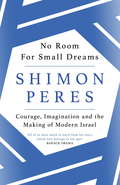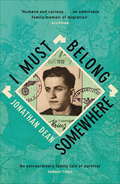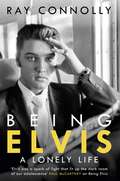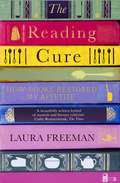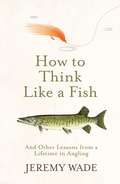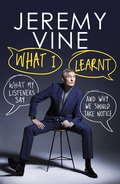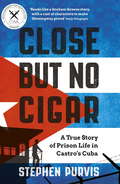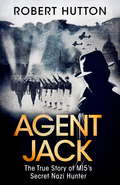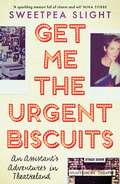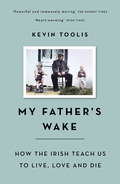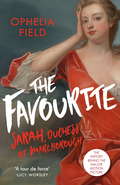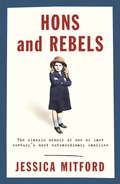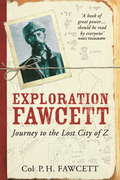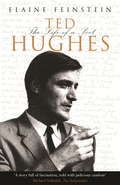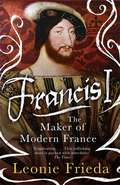- Table View
- List View
No Room for Small Dreams: Courage, Imagination and the Making of Modern Israel
by Shimon PeresIn 1934, eleven-year-old Shimon Peres emigrated to the land of Israel from his native Poland, leaving behind an extended family who would later be murdered in the Holocaust. Few back then would have predicted that this young man would eventually become one of the towering figures of the twentieth century. Peres would indeed go on to serve the new state as prime minister, president, foreign minister, and the head of several other ministries. In this, his final work, finished only weeks before his passing, Peres offers a long-awaited examination of the crucial turning-points in Israeli history through the prism of having been a decision-maker and eyewitness. Told with the frankness of someone aware this would likely be his final statement, No Room for Small Dreams spans decades and events, examining pivotal moments in Israel's rise. Peres explores what makes for a great leader, how to make hard choices in a climate of uncertainty and distress, the challenges of balancing principles with policies, and the liberating nature of imagination and unpredicted innovation. In doing so, he not only charts a better path forward for his beloved country but provides deep and universal wisdom for younger generations who seek to lead - be it in politics, business or the broader service of making our planet a safer, more peaceful and just place.
Jonas Kaufmann: In Conversation With
by Thomas Voigt'The most sought-after tenor in the world', the greatest tenor of today', 'the new king of tenors' - for years Jonas Kaufmann has occupied a unique status among the world's greatest opera singers.Thomas Voigt's revealing biography, written in collaboration with Kaufmann, reflects on the singer's artistic development in recent years; his work in the recording studio; his relationship to Verdi and Wagner; and much more. The book includes contributions from Plácido Domingo, Anja Harteros, Antonio Pappano, Helmut Deutsch and Jürgen Kesting, as well as many striking photographs.Kaufmann was born in Munich in 1969. Soon after training at the University of Music and Performing Arts he was invited to make his debut in theatres such as the Stuttgart Opera and Hamburg State Opera, as well as international appearances at the Lyric Opera of Chicago, the Paris Opera and La Scala in Milan. He made his Salzburg Festival debut in 1999 in a new production of Busoni's Doktor Faust. He performed the role of Don José in Bizet's Carmen at Covent Garden in 2006 and made his acclaimed debut as Alfredo in Verdi's La Traviata at the Metropolitan Opera alongside Angela Gheorghiu. He has sung leading tenor roles in the operas of Richard Wagner with success in Germany and abroad, and is also a highly accomplished Lieder singer. In 2015 Kaufmann became the first German to perform the British seafaring anthem 'Rule, Britannia!' at the Last Night of the Proms.No wonder that the New York Times has described Jonas Kaufmann as 'a box-office draw, and ... the most important versatile tenor of his generation'.
Jonas Kaufmann: In Conversation With
by Thomas VoigtJonas Kaufmann is a phenomenon. With his musicality, his vocal technique and his expressive powers - to say nothing of his matinée-idol good looks - he is widely regarded as the greatest tenor of today. Thomas Voigt's intimate biography, written in collaboration with Kaufmann, reflects on the singer's artistic development in recent years; his work in the recording studio; his relationship to Verdi and Wagner; the sacrifices of success; and much more. It gives unparalleled insight into the world of one of the most captivating opera singers of the international stage.
I Must Belong Somewhere: An extraordinary family tale of survival
by Jonathan Dean'An extraordinary family tale of survival' Sunday TimesJonathan Dean's great-grandfather, David Schapira, fled the Russian threat in Ukraine for Vienna in 1914. Blinded in the First World War, he survived to find love and start a family, only to be sent to a concentration camp during the next war. David's son, Heinz, was also a refugee. In 1939, aged 16, he embarked on a nail-biting journey to London, to escape his fate as an Austrian Jew. Drawing on David's memoir and Heinz's wartime diaries, Dean visits the places that changed the course of his family tree - Vienna, Cologne, Ukraine - where he finds history repeating itself and meets a new wave of people leaving loved ones for an uncertain future.I Must Belong Somewhere is an unforgettable family tale of exile and survival, and a powerful meditation on what it means to be a refugee today.
Being Elvis: The perfect companion to Baz Luhrmann’s major biopic
by Ray ConnollyThe perfect companion to Baz Luhrmann's forthcoming biopic Elvis, a major motion picture starring Tom Hanks and Austin Butler.What was it like to be Elvis Presley? What did it feel like when impossible fame made him its prisoner? As the world's first rock star there was no one to tell him what to expect, no one with whom he could share the burden of being himself - of being Elvis.On the outside he was all charm, sex appeal, outrageously confident on stage and stunningly gifted in the recording studio. To his fans he seemed to have it all. He was Elvis. With his voice and style influencing succeeding generations of musicians, he should have been free to sing any song he liked, to star in any film he was offered, and to tour in any country he chose. But he wasn't free. The circumstances of his poor beginnings in the American South, which, as he blended gospel music with black rhythm and blues and white country songs, helped him create rock and roll, had left him with a lifelong vulnerability. Made rich and famous beyond his wildest imaginings when he mortgaged his talent to the machinations of his manager, 'Colonel' Tom Parker, there would be an inevitable price to pay. Though he daydreamed of becoming a serious film actor, instead he grew to despise his own movies and many of the songs he had to sing in them. He could have rebelled. But he didn't. Why? In the Seventies, as the hits rolled in again, and millions of fans saw him in a second career as he sang his way across America, he talked of wanting to tour the world. But he never did. What was stopping him?BEING ELVIS takes a clear-eyed look at the most-loved entertainer ever, and finds an unusual boy with a dazzling talent who grew up to change popular culture; a man who sold a billion records and had more hits than any other singer, but who became trapped by his own frailties in the loneliness of fame.
Being Elvis: The perfect companion to Baz Luhrmann’s major biopic
by Ray ConnollyThe perfect companion to Baz Luhrmann's forthcoming biopic Elvis, a major motion picture starring Tom Hanks and Austin Butler.What was it like to be Elvis Presley? What did it feel like when impossible fame made him its prisoner? As the world's first rock star there was no one to tell him what to expect, no one with whom he could share the burden of being himself - of being Elvis.On the outside he was all charm, sex appeal, outrageously confident on stage and stunningly gifted in the recording studio. To his fans he seemed to have it all. He was Elvis. With his voice and style influencing succeeding generations of musicians, he should have been free to sing any song he liked, to star in any film he was offered, and to tour in any country he chose. But he wasn't free. The circumstances of his poor beginnings in the American South, which, as he blended gospel music with black rhythm and blues and white country songs, helped him create rock and roll, had left him with a lifelong vulnerability. Made rich and famous beyond his wildest imaginings when he mortgaged his talent to the machinations of his manager, 'Colonel' Tom Parker, there would be an inevitable price to pay. Though he daydreamed of becoming a serious film actor, instead he grew to despise his own movies and many of the songs he had to sing in them. He could have rebelled. But he didn't. Why? In the Seventies, as the hits rolled in again, and millions of fans saw him in a second career as he sang his way across America, he talked of wanting to tour the world. But he never did. What was stopping him?BEING ELVIS takes a clear-eyed look at the most-loved entertainer ever, and finds an unusual boy with a dazzling talent who grew up to change popular culture; a man who sold a billion records and had more hits than any other singer, but who became trapped by his own frailties in the loneliness of fame.
The Reading Cure: How Books Restored My Appetite
by Laura Freeman'Freeman's pleasure in the food of literature ... is infectious. The Reading Cure will speak to anyone who has ever felt pain and found solace in a book' Bee WilsonAt the age of fourteen, Laura Freeman was diagnosed with anorexia. But even when recovery seemed impossible, the one appetite she never lost was her love of reading. Slowly, book by book, Laura re-discovered how to enjoy food - and life - through literature.
How to Think Like a Fish: And Other Lessons from a Lifetime in Angling
by Jeremy WadeJeremy Wade has caught an unparalleled array of outsize and outlandish fish from challenging locations all over the world - goliath tigerfish from the Congo, arapaima from the Amazon, 'giant devil catfish' from the Himalayan foothills . . . As his catches attract increasing public attention, many people ask him how they can improve their own fishing results.This book is his reply. Sparse on the details of technique, it's about the simple, fundamental principles - a mindset for success. Part science, part art, and part elusive something else, this, he says, is within every angler's ability to develop. How to Think Like a Fishis the distillation of a life spent fishing. Along the way readers will learn when to let instinct override logic. Why less time can bring better results than more. Which details are vital and which may be irrelevant. And how a 'non-result' can be a result. Thoughtful and funny, brimming with wisdom and adventure, here is the book for any angler - novice or old hand - who wants to catch the fish that have so far eluded them.
What I Learnt: What My Listeners Say and Why We Should Hear Them
by Jeremy VineJeremy Vine has been presenting a BBC Radio 2 show since 2003 that attracts more than seven million listeners. In that time he calculates he has taken more than 25,000 calls on topical subjects - big issues and small ones: on life, love, lollipop ladies and poisonous plants. But what have the callers told him? In the age of Brexit and Donald Trump, is the world now being run by Radio 2 listeners? If you listen to Radio 4, Brexit was a shock. If you are a Radio 2 listener it wouldn't have surprised you at all. Where Jeremy's callers once expressed a kind of resignation ('But what can you do?' or the gloomy rejoinder: 'You have to laugh'), now they tend to give him their views expecting to be heeded. They have not called in to entertain the audience. They expect to take the wheel of the car and drive.Listener wisdom is far more valuable than most of what we hear from appointed spokespeople. What was the response when Jeremy asked: 'Have you ever been pecked in the eye by a gannet?' Which subjects are most likely to start pitched warfare between different sections of the audience? (Answer: old people using buses, old people NOT using buses, cellophane, or Tony Blair saying anything.)In a book punctuated by vivid anecdotes and laugh-out-loud moments, Jeremy Vine explains what it's like to hit a button and hear - totally unvarnished and unspun - the voices of so-called ordinary people. And why they are not so ordinary after all.
Your Call: What My Listeners Say – and Why We Should Take Note
by Jeremy Vine'Full of glorious examples of caller wisdom [with] laugh-out-loud anecdotes' Allison PearsonHaving taken over 25,000 listener calls on his BBC Radio 2 lunchtime show, Jeremy Vine decided it was time to take stock of the wisdom his listeners have imparted over the airwaves. And it is clearer than ever before that caller wisdom is far more valuable than most of what we hear from 'the experts'. The voice of the so-called 'ordinary person' - totally unvarnished and unspun - turns out to be not so ordinary after all.These moments of truth could not have come at a more pertinent time - with world politics, war and Brexit in the fray. And it always helps to make people laugh. This is his hilarious account of lessons learnt from listeners, life and Len Goodman by way of musings on everything including love, lollipop ladies and poisonous plants.
Close But No Cigar: A True Story of Prison Life in Castro's Cuba
by Stephen PurvisWINNER OF THE CRIME WRITERS' ASSOCIATION GOLD DAGGER FOR NON-FICTION 2017'In its tragic absurdity, Close But No Cigar reads like a Graham Greene story, with a cast of characters to make Hemingway proud' Daily TelegraphFor over a decade Stephen Purvis had been a pillar of Havana's expat community, one of many foreign businessmen investing in Cuba's crawl from Cold War communism towards modernity. But for reasons unknown to him he was also under State Security's microscope. One morning during the height of President Raúl Castro's purges in 2012, while his family slept, the unmarked Ladas of State Security arrived at his home and he was taken away into the absurd and brutal world of Cuban justice.In this engrossing memoir, Purvis recounts his fifteen-month ordeal. Accused at first of selling state secrets, he is taken to the notorious interrogation centre Villa Marista, where he endures brutal conditions designed by the KGB and Stasi to break the bodies and minds of spies and political prisoners, and resists the paranoia and incompetence of his jailers. Later, held in a maximum-security prison, he finds himself surrounded by a motley crew of convicts: people-smugglers and drug-runners together with a handful of confused businessmen also awaiting formal charges.From his arrest to his farcical secret trial and sudden release, Purvis exposes the madness of modern Cuba with wit, grit and a sharp eye for character. As tourists flock to Havana to marvel at a city frozen in time, he shows that despite reforms and international reconciliation the Castro regime remains a corrupt, dictatorial relic. Close But No Cigar is part thriller, part comedy and part morality tale, but most of all a true story that takes the reader into a dark side of a sunny place that remains an enigma.
Close But No Cigar: A True Story of Prison Life in Castro's Cuba
by Stephen Purvis'In its tragic absurdity, Close but No Cigar reads like a Graham Greene story, with a cast of characters to make Hemingway proud ... [This] tale should be read by anyone who wants to understand what lies beyond the beaches and Bacardi [of Cuba]' DAILY TELEGRAPHFor over a decade Stephen Purvis had been a pillar of Havana's expat community, one of many foreign businessmen investing in Cuba's crawl from Cold War communism towards modernity. But for reasons unknown to him he was also under State Security's microscope. One morning during the height of President Raúl Castro's purges in 2012, while his family slept the unmarked Ladas of State Security arrived at his home and he was taken away into the absurd and brutal world of Cuban justice.In this engrossing memoir, Purvis recounts his fifteen-month ordeal. Accused at first of selling state secrets, he is taken to the notorious interrogation centre Villa Marista, where he endures brutal conditions designed by the KGB and Stasi to break the bodies and minds of spies and political prisoners, and resists the paranoia and incompetence of his jailers. Later, held in a maximum-security prison, he finds himself surrounded by a motley crew of convicts: people-smugglers and drug-runners together with a handful of confused businessmen also awaiting formal charges.From his arrest to his farcical secret trial and sudden release, Purvis exposes the madness of modern Cuba with wit, grit and a sharp eye for character. As tourists flock to Havana to marvel at a city frozen in time, he shows that despite reforms and international reconciliation the Castro regime remains a corrupt, dictatorial relic. CLOSE BUT NO CIGAR is part thriller, part comedy and part morality tale, but most of all a true story that takes the reader into a dark side of a sunny place that remains an enigma.
Agent Jack: The True Story of MI5's Secret Nazi Hunter
by Robert Hutton'Highly readable' Ben Macintyre'Pacy, original and frequently chilling' Henry HemmingJune 1940. Britain is Europe's final bastion of freedom - and Hitler's next target. But not everyone fears a Nazi invasion. In factories, offices and suburban homes are men and women determined to do all they can to hasten it.Throughout the Second World War, Britain's defence against the enemy within was Eric Roberts, a former bank clerk from Epsom. Equipped with an extraordinary ability to make people trust him, he was recruited into the shadowy world of espionage by the great spymaster Maxwell Knight. Roberts penetrated first the Communist Party and then the British Union of Fascists, before playing his greatest role for MI5 - as Hitler's man in London. Codenamed Jack King, he single-handedly built a network of hundreds of British Nazi sympathisers, with many passing secrets to him in the mistaken belief that he was a Gestapo officer. Operation Fifth Column, run by a brilliant woman scientist and a Jewish aristocrat with a sideline in bomb disposal, was kept so secret it was omitted from the reports MI5 sent to Winston Churchill. In a narrative that grips like a thriller, Robert Hutton tells the fascinating story of an operation whose existence has only recently come to light. Drawing on newly declassified documents and private family archives, Agent Jack shatters the comfortable notion that Britain could never have succumbed to fascism, and celebrates - at last - the courage of individuals who protected the country they loved at great personal risk.
Get Me the Urgent Biscuits: An Assistant's Adventures in Theatreland
by Sweetpea Slight'A sparkling memoir ... A delight from start to finish' NINA STIBBE 'Anyone who loves the theatre will love this book' ZOË WANAMAKER In 1980s London, Sweetpea Slight is en route to drama school when she is snapped up to work as an assistant to the maverick theatre producer Thelma Holt. Full of wit, charm and backstage intrigue, her irresistible memoir of the resulting twenty years is at once the poignant story of a young woman coming of age, and an exhilarating journey down the rabbit hole into the enchanting world of theatre.
Get Me the Urgent Biscuits: An Assistants Adventures in Theatreland
by Sweetpea Slight'A sparkling memoir ... A delight from start to finish' NINA STIBBE 'Anyone who loves the theatre will love this book' ZOË WANAMAKER In 1980s London, Sweetpea Slight is en route to drama school when she is snapped up to work as an assistant to the maverick theatre producer Thelma Holt. Full of wit, charm and backstage intrigue, her irresistible memoir of the resulting twenty years is at once the poignant story of a young woman coming of age, and an exhilarating journey down the rabbit hole into the enchanting world of theatre.
My Father's Wake: How the Irish Teach Us to Live, Love and Die
by Kevin ToolisDeath is a whisper in the Anglo-Saxon world. But on a remote island, off the coast of County Mayo, it has a louder voice. The local radio station runs a thrice-daily roll-call of the recently departed. The islanders keep vigil with the corpse and share in the sorrow of the bereaved. The living and the dead are bound together in the oldest rite of humanity. In My Father's Wake, Kevin Toolis gives an intimate, eye-witness account of the death and wake of his father, celebrating the spiritual depth of the Irish Wake and asking if we too can find a better way to deal with our mortality, by living and loving in the acceptance of death.
The Favourite: The Life of Sarah Churchill and the History Behind the Major Motion Picture
by Ophelia Field'An incredible story crackling with royal passion, envy, ambition and betrayal ... Field's account of the psychological power play between Queen Anne and her confidante is surely definitive. A tour de force' Lucy WorsleySarah Churchill, Duchess of Marlborough, was as glamorous as she was controversial. Politically influential and independently powerful, she was an intimate, and then a blackmailer, of Queen Anne, accusing her of keeping lesbian favourites - including Sarah's own cousin Abigail Masham.Ophelia Field's masterly biography brings Sarah Churchill's own voice, passionate and intelligent, back to life. Here is an unforgettable portrait of a woman who cared intensely about how we would remember her - perfect for fans interested in the history behind the major motion picture starring Rachel Weisz with Olivia Colman and Emma Stone.
The Favourite: The Life of Sarah Churchill and the History Behind the Major Motion Picture
by Ophelia Field'An incredible story crackling with royal passion, envy, ambition and betrayal ... Field's account of the psychological power play between Queen Anne and her confidante is surely definitive. A tour de force' Lucy WorsleySarah Churchill, Duchess of Marlborough (1660-1774), was as glamorous as she was controversial. Politically influential and independently powerful, she was an intimate, and then a blackmailer, of Queen Anne, accusing her of keeping lesbian favourites - including Sarah's own cousin Abigail Masham.Ophelia Field's masterly biography brings Sarah Churchill's own voice, passionate and intelligent, back to life. Here is an unforgettable portrait of a woman who cared intensely about how we would remember her.
Hons and Rebels: The Mitford Family Memoir (W&N Essentials)
by Jessica Mitford'This book is just about my favourite book of all time ... I'm not entirely convinced I could like somebody who didn't like this book ... it's funny and moving and gives you an insight into this extraordinary moment as the war is about to begin ... it's so vivid, and what's more, it's incredibly current' Robert Rinder, BBC Radio 4'Wonderfully funny and very poignant' Philip Toynbee'More than an extremely amusing autobiography ... she has evoked a whole generation. Her book is full of the music of time' SUNDAY TIMES'Whenever I read the words "Peer's Daughter" in a headline,' Lady Redesdale once sadly remarked, 'I know it's going to be something about one of you children.' The Mitford family is one of the century's most enigmatic, made notorious by Nancy's novels, Diana's marriage to Sir Oswald Mosley, Unity's infatuation with Hitler, Debo's marriage to a duke and Jessica's passionate commitment to communism. Hons and Rebels is an enchanting and deeply absorbing memoir of an isolated and eccentric upbringing which conceals beneath its witty, light-hearted surface much wisdom and depth of feeling.
Hons and Rebels: The Mitford Family Memoir
by Jessica Mitford'Whenever I read the words "Peer's Daughter" in a headline,' Lady Redesdale once sadly remarked, 'I know it's going to be something about one of you children.' The Mitford family is one of the century's most enigmatic, made notorious by Nancy's novels, Diana's marriage to Sir Oswald Mosley, Unity's infatuation with Hitler, Debo's marriage to a duke and Jessica's passionate commitment to communism. Hons and Rebels is an enchanting and deeply absorbing memoir of an isolated and eccentric upbringing which conceals beneath its witty, light-hearted surface much wisdom and depth of feeling.
Exploration Fawcett
by Col. Percy FawcettThe life of Colonel Fawcett is now the subject of the major motion picture The Lost City of Z.The disappearance of Colonel Fawcett in the Matto Grosso remains one of the great unsolved mysteries. In 1925, Fawcett was convinced that he had discovered the location of a lost city; he had set out with two companions, one of whom was his eldest son, to destination 'Z', never to be heard of again. His younger son, Brian Fawcett, has compiled this book from letters and records left by his father, whose last written words to his wife were: 'You need have no fear of any failure . . .' This is the thrilling and mysterious account of Fawcett's ten years of travels in deadly jungles and forests in search of a secret city.
Exploration Fawcett
by Percy FawcettThe disappearance of Colonel Fawcett in the Matto Grosso remains one of the great unsolved mysteries of today. In 1925 Fawcett was convinced that he had discovered the location of a lost city; he had set out with two companions, one of whom was his eldest son, to destination 'Z', never to be heard of again. His younger son, Brian Fawcett, has compiled this book from letters and records left by his father whose last written words to his wife were: 'You need have no fear of any failure...' This thrilling and mysterious account of Fawcett's ten years of travels in deadly jungles and forests in search of a secret city was compiled from manuscripts, letters and logbooks by his son.
Ted Hughes: The Life of a Poet
by Elaine FeinsteinTed Hughes is one of the greatest English poets of this century, yet his life was dogged by tragedy and controversy. His marriage to the American poet Sylvia Plath marked his whole life and he never entirely recovered from her suicide in 1963, though he chose to remain silent on the subject for more than 30 years. Many people, including his friend Al Alvarez, have held Hughes's adultery responsible for Plath's death. Elaine Feinstein first met Hughes in 1969, and she was a good friend of his and his sister Olwyn's, both of whom guarded the Plath estate. She knows many of the European and America poets who so influenced Hughes - Seamus Heaney, Thom Gunn, Miroslav Holub, and knows the world in which both he and Plath moved.
Francis I: The Maker of Modern France
by Leonie FriedaFrancis I (1494-1547) was inconstant, amorous, hot-headed and flawed. Arguably he was also the most significant king that France ever had. A contemporary of Henry VIII of England, Francis saw himself as the first Renaissance king. A courageous and heroic warrior, he was also a keen aesthete, an accomplished diplomat and an energetic ruler who turned his country into a force to be reckoned with. Bestselling historian Leonie Frieda's comprehensive and sympathetic account explores the life of the most human of all Renaissance monarchs - and the most enigmatic.
Francis I: The Maker of Modern France
by Leonie FriedaFrancis I (1494-1547) was inconstant, amorous, hot-headed and flawed. Arguably he was also the most significant king that France ever had. A contemporary of Henry VIII of England, Francis saw himself as the first Renaissance king. A courageous and heroic warrior, he was also a keen aesthete, an accomplished diplomat and an energetic ruler who turned his country into a force to be reckoned with. Bestselling historian Leonie Frieda's comprehensive and sympathetic account explores the life of the most human of all Renaissance monarchs - and the most enigmatic.
